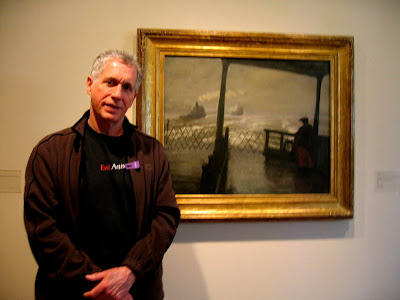How to Teach Your Children to Hate Art

If you'd like to teach your children to hate the fine arts, I recommend taking them on a trip to one of the really big museums, say the National Gallery of Art or the Metropolitan Museum. Start in the galleries with the big bright splashy abstract paintings and sculpture and systematically work your way through all the galleries, going backwards in time until you hit the cases showing the fractured shards of Etruscan vases. If you find you've skipped any galleries, go back and hit them, as you don't want to miss anything. If you can arrange for one of your kids to be hungry, so much the better.
Obviously, I'm talking about culture as a forced march activity. It cannot be that. While the huge museums have their place, I think you get a bigger bang for your buck at the smaller museums. Art after all, is about some things that are subtle and mysterious- rhythm, balance, flavor, mood. You absolutely can't take these things in with a shovel. One of the smaller museums in Washington, D.C. that's easy on the eyes is the Phillips Collection
Here's a few more of the paintings I wanted to show you from my visit there last weekend.
Above is a work I have loved for years, a view of the famous Staten Island Ferry by John Sloan, on of the prominent members of the Ashcan School of painters. Typical of their early work, it is very concerned with atmosphere, but in terms of greys, browns and blacks. Breaking the subtle greens of the water's surface are the churning wakes of the ferry. These choppy white patches are contrasted with the solid slanting black uprights on the ferry. As the boat lists over towards the right, the lone passenger counterbalances as he leans back to the left. So often it seems skilled artist can exploit an unexpected leaning form to give a sense of movement and life to their painting.
Here's a portrait by Guy Pene DuBois. If you like your sitter, you have to build just the right space for them to live and breathe in. I love the way the overstuffed arm chair crowds the room and squeezes the strip of white wall behind the woman's head. A telling detail is the way the darks of the chair surround the highlighted hands and head of the woman. Notice how her dark hair frames the face with more of the dark tones we saw in the chair. DuBois was so good with color because he knew how to see the dark and light patterns as they emerged in his paintings. He often does very elegant fingers, and especially with the hand on the right, I think he pulls that off once again here.
Finally here's an early Rockwell Kent oil. I generally like his wood engravings most of all, but this oil I think is one of his best. I lost count of how many horse are pulling the roller that's supposed to mash down the snow (this was before engine driven snow plows showed up in the rural countryside). But look at how neatly Kent divides them into two separate masses to keep them from looking like a big undifferentiated herd. This is one of the artists jobs- to find expressive structure for us. Realize here Kent at best only had the briefest sketches to work from. His horses here would have been invented straight out of his fertile imagination.
One other great passage in Kent's oil is the immediate foreground. He breaks it up with a giant irregularly shaped shadow that, like the horses, seems to beckon us down the hill.
Many years ago when I first started going to art museums I often felt frustrated that many of works on display didn't appeal to me. But I figured if I just kept going and looking that over time, I'd learn to appreciate more and eventually most of what they would have on exhibit. Guess what. It never happened.
I realize now art museums are in a sort of catering business for our eyes. You can only eat so much and then you simply have to stop and digest what you've taken in. My goal now when I go to a museum is to find two or maybe three paintings that I really connect with. Sometimes they can grab my full attention for whole minutes and I'll just fall into them. Then I'm off again to find what's best on the smorgasbord. I don't over eat, but I really relish the few pieces I dig into.




